National Cemetery Administration
History of Government-Furnished Headstones and Markers
The history of government headstones has an identity of its own apart from development of the National Cemetery Administration. The original standard grave marker precedes the establishment of national cemeteries in 1862 and actually has its origin in the frontier days of this country prior to the Civil War.
Wooden Headboards as Grave Markers
In the normal course of events, soldiers died and garrison commanders were compelled to bury their dead, mainly in cemetery plots within post reservations. Those not so fortunate were buried where death occurred. In the course of time, a fairly uniform method of marking burials came into being. A wooden board with a rounded top and bearing a registration number or inscription became the standard. No centralized system for recording burials existed.
Although the system may have been adequate for frontier forces, it could scarcely meet the needs of the national army that came into being at the beginning of the Civil War. Two months after the first battle of Manassas, the War Department issued General Orders number 75, September 11, 1861, which made commanders of national forces responsible for burials and marking graves. In the same General Orders, the Quartermaster General of the Army was directed to provide headboards as well as blank books and forms for the preservation of burial records. War Department General Orders number 75 created the first organized system of marking graves.
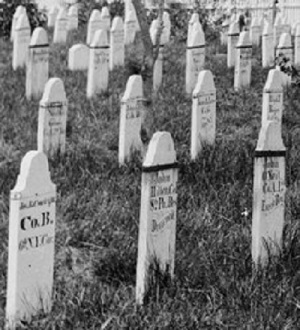 Detail of a photograph of Alexandria National Cemetery, Virginia, 1862–1869, showing graves marked by wooden headboards. Photographer, probably Andrew Russell. (Library of Congress)
Detail of a photograph of Alexandria National Cemetery, Virginia, 1862–1869, showing graves marked by wooden headboards. Photographer, probably Andrew Russell. (Library of Congress)Following capitulation of the Confederate States Army, a concerted effort was undertaken to recover the dead from their temporary wartime burial places and to accomplish their permanent reburial in national cemeteries. Little thought was given to the suitability of the round top wooden headboards as a marker for the graves of soldiers fallen in battle. In 1865, when burials in national cemeteries approached 100,000, serious consideration began to be given to the long range economy of maintaining the wooden headboards then in use. It was estimated that the total recovered dead of the Civil War would be around 300,000 and, considering the average cost of a headboard at $1.23 each and a life expectancy of not more than five years, it became obvious that the original and replacement costs would exceed $1 million over a 20-year period.
Aside from the problems of economics surrounding the use of wooden headboards, public sentiment was turning to a more permanent mode of marking graves. Several years of controversy ensued within the War Department as to the type of headstone that ought to be used in lieu of the wooden headboard. There were those who favored the use of marble and those who favored galvanized iron coated with zinc. The controversy between marble and galvanized iron continued with intermittent periods of vigor and apathy for seven years.
Civil War Headstones
In 1873, Secretary of War William W. Belknap adopted the first design for stones to be erected in national cemeteries. For the known dead, the department adopted a slab design of marble or durable stone four inches thick, 10 inches wide and 12 inches in height extending above the ground. The part above the ground was polished and the top slightly curved. The number of the grave, rank, name of the soldier and the name of the state were cut on the front face. This original design for the permanent headstone was referred to as the "Civil War" type, and was furnished for members of the Union Army only. The stone featured a sunken shield in which the inscription appeared in bas relief.
For the unknown dead, the stone was a block of marble or durable stone 6 inches square, and 30 inches long. The top and 4 inches of the sides of the upper part were finished and the number of the grave cut on the top.
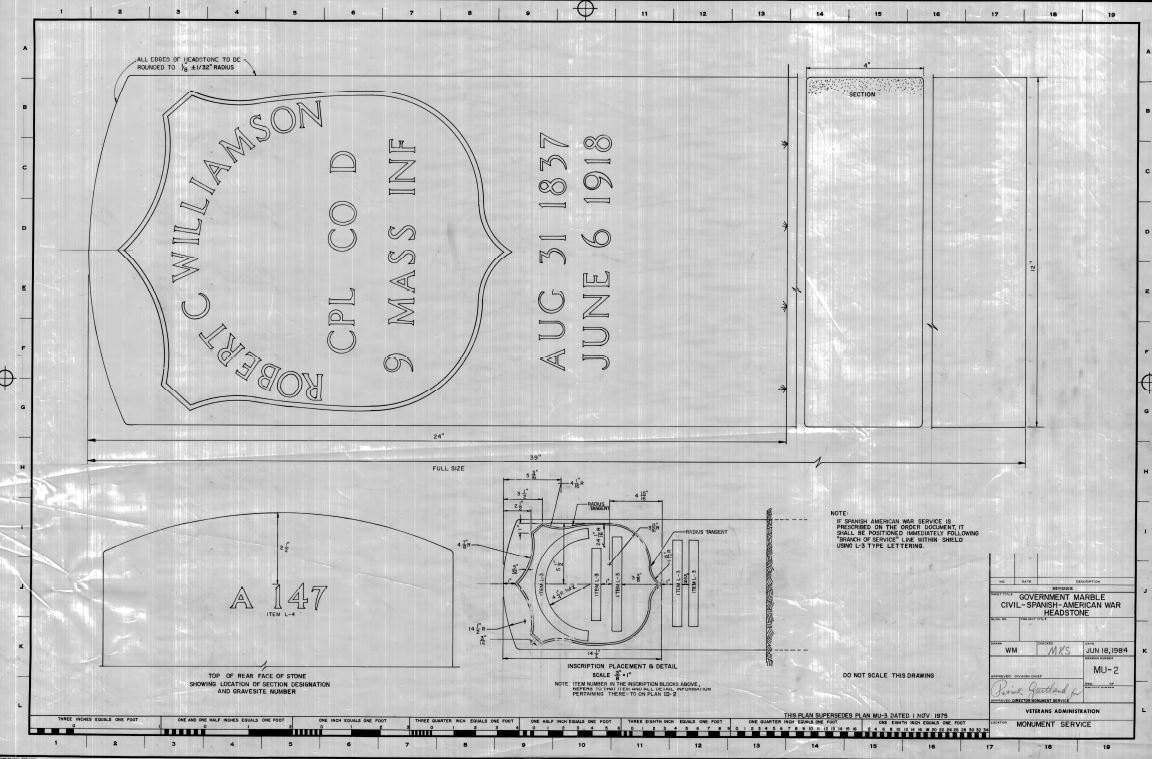 Technical drawing from 1984 showing the specifications for a government-issued "Shield" headstone used during the post-Civil War era through World War I.
Technical drawing from 1984 showing the specifications for a government-issued "Shield" headstone used during the post-Civil War era through World War I.On February 3, 1879, Congress authorized the furnishing of stones for the unmarked graves of veterans in private cemeteries. Insofar as known, the only type used was the same as used for the known dead in national cemeteries.
The Civil War type of headstone was furnished not only for the unmarked graves of that war but for the unmarked graves of eligible deceased of the Revolutionary War, War of 1812, Mexican War and Indian Campaigns. At the conclusion of the Spanish-American War, it was decided that the same design of headstone should be used to mark the graves of eligible deceased of that war as well.
Civil War 6×6 Unknown Grave Markers
Graves of unknown soldiers in the national cemeteries are commonplace and marked in many different ways. While the Tomb of the Unknown Soldier in the Army's Arlington National Cemetery is the most culturally recognizable unknown grave, VA national cemeteries also have less grand examples of unknown burials that span the early 19th century through the Korean War. While most are marked with the same upright headstone used to identify other fallen soldiers of their era, some feature more unique designs.
At St. Augustine National Cemetery in Florida, for instance, three coquina pyramids erected in 1842 mark the collective reinterment of nearly 200 soldiers killed in the Florida Indian Wars (1835–1842). At San Francisco National Cemetery, a rough-hewn granite American eagle marks the gravesite of 571 unknowns relocated from other parts of the cemetery in 1934. The most common form of unknown marker, however, is the simple 6×6-inch stone that adorns the graves of thousands of Civil War soldiers. Read More »
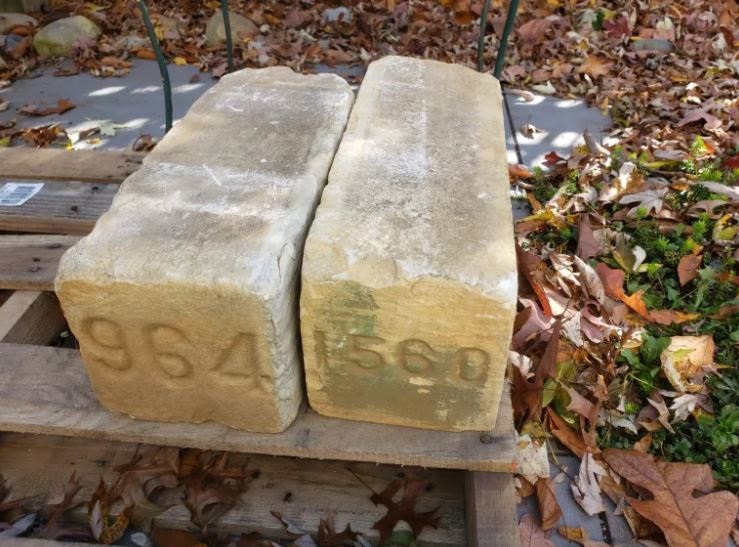 Two of the 6×6-inch stone markers from Annapolis National Cemetery evaluated by NCA historians and retained for the administration's artifact collection in 2022. After the Civil War, the Army installed the markers at the gravesites of thousands of unidentified Union soldiers and sailors.
Two of the 6×6-inch stone markers from Annapolis National Cemetery evaluated by NCA historians and retained for the administration's artifact collection in 2022. After the Civil War, the Army installed the markers at the gravesites of thousands of unidentified Union soldiers and sailors.Confederate Headstones
In 1902, a study was done as to determine the durability of the type of headstone then in use. The study resulted in a change implemented in 1903. The height of the stone was increased to 39 inches, the width to 12 inches, and the thickness to 4 inches.
The use of stone blocks for marking unknown graves in national cemeteries was discontinued on October 21, 1903, and the graves were marked with the same design as those furnished for the known dead.
In order to ensure that all graves in military-controlled cemeteries were marked appropriately, Congress on April 28, 1904 (58th Cong., Ch. 1762), also authorized the furnishing of headstones for the unmarked graves of civilians buried in post cemeteries.
 Technical drawing from 1968 showing the specifications for a government-issued Confederate headstone with the Southern Cross of Honor emblem.
Technical drawing from 1968 showing the specifications for a government-issued Confederate headstone with the Southern Cross of Honor emblem.The question of permanently marking graves of Confederate deceased in national cemeteries and Confederate burial plots resulted in the Act of March 9, 1906 (P.L. 38, 59th Cong., Ch. 631), authorizing the furnishing of headstones for the graves of Confederates who died, primarily in Union prison camps and were buried in federal cemeteries.
Congress adopted the same size and material for Confederate headstones as headstones for Civil-Spanish War deceased. The design varied in that the top was pointed instead of rounded and the shield was omitted. Apocryphally, it has been said that the pointed top was adopted to prevent "Yankees" from sitting on Confederate headstones. An act on February 26, 1929 (70th Cong., Ch. 324), authorized the furnishing of this type of stone for graves in private cemeteries, as well.
On May 26, 1930, the War Department implemented regulations for Confederate headstones that also authorized the inscription of the Confederate Cross of Honor in a small circle on the front face of the stone above the standard inscription of the soldier's name, rank, company and regiment.
General Headstones
Following World War I, a board of officers composed of Assistant Secretary of War J.M. Wainwright, Army Chief of Staff General John J. Pershing and Quartermaster General Harry L. Rogers adopted a new design to be used for all graves except those of veterans of the Civil and Spanish-American Wars.
This stone was of the slab design referred to as "General" type, slightly rounded at the top, of American white marble, 42 inches long, 13 inches wide and four inches thick. The inscription on the front face would include the name of the soldier, his rank, regiment, division, date of death and state from which he came.
For the first time, a religious emblem was adopted for use on government headstones. The religious emblem was authorized for use at this time only on the General type stone. The choice of emblem was limited to the Latin Cross for the Christian faith and the Star of David for the Jewish faith.
In April 1941, the Under Secretary of War approved the use of granite material for stones similar to the existing designs of the Civil and Spanish-American Wars, and the Confederate and General types. These granite headstones were discontinued in 1947, however, because of the inability to procure them within the price limitations authorized by the War Department.
Other Markers
To assure the marking of all graves of all eligible members of the armed forces and veterans interred in private cemeteries, who due to cemetery regulations were permitted only a flat marker type, the following designs were approved by the Assistant Secretary of War: flat marble marker adopted August 11, 1936; flat granite marker adopted September 13, 1939. An act of April 18, 1940, authorized the use of other materials and the standard. Flat bronze markers were adopted on July 12, 1940. (A new design was approved beginning with fiscal year 1973).
The marble and granite flat markers are 24 inches in length, 12 inches in width, and 4 inches deep with incised inscriptions. The bronze flat marker is 24 inches in length, 12 inches in width and three-sixteenths of an inch thick with raised lettering. The markers are placed flush with the ground and the inscription is placed parallel to the greatest dimension of the marker. The inscription includes the name of the deceased, state, rank, organization, dates of death and religious emblem above the inscription.
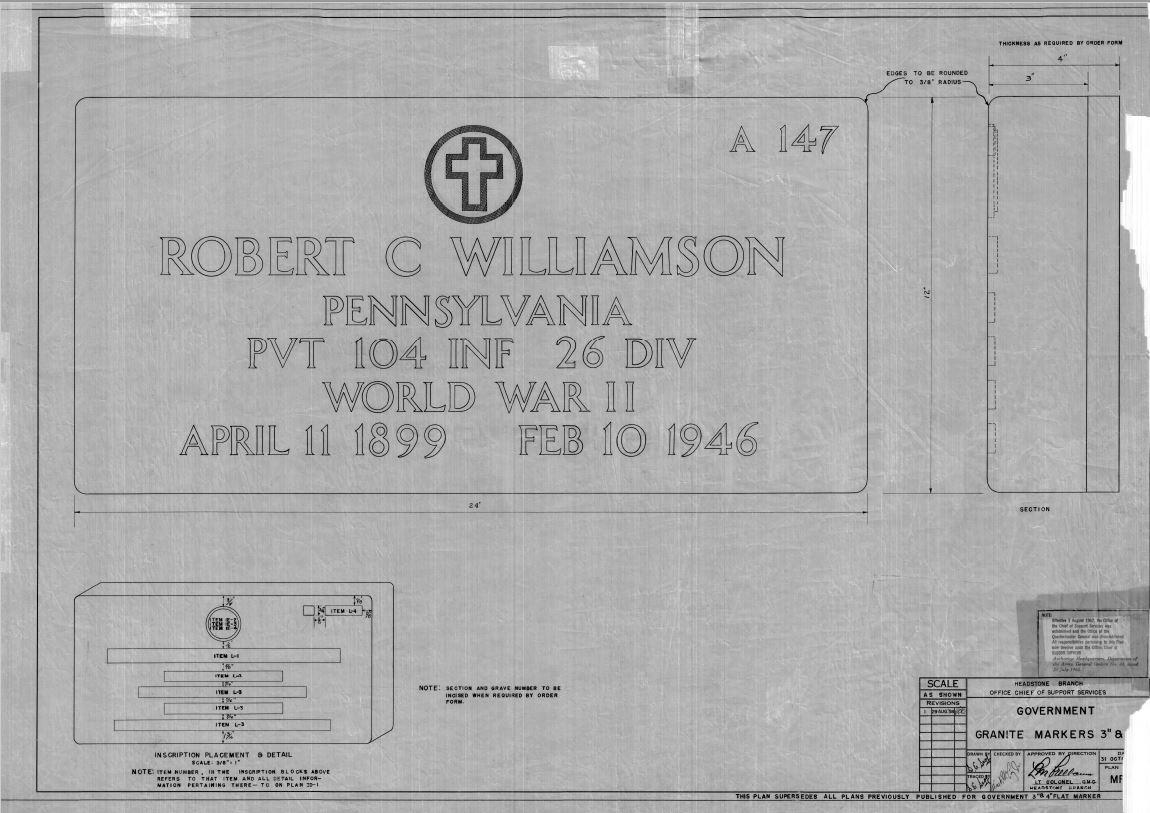 Technical drawing showing the specifications for a government-issued marble flat marker, first authorized in 1936.
Technical drawing showing the specifications for a government-issued marble flat marker, first authorized in 1936.The Under Secretary of War authorized the addition of the date of birth as part of authorized inscription in 1944. After the war ended, he authorized World War I or II as part of the inscription.
On December 1, 1948, the Secretary of War authorized a flat granite marker for use in the new national cemeteries in Hawaii (National Memorial Cemetery of the Pacific) and Puerto Rico (Puerto Rico National Cemetery).
This marker is of the same design that had been previously authorized for private cemeteries with the exception of the thickness, which was reduced to three inches. In 1951, the same type of marker was approved for use in the new Willamette National Cemetery in Portland, OR.
The Assistant Secretary of the Army approved designs to be used for the marking of group burial interments in national cemeteries in 1950.
With the growing use of above-ground columbaria in cemeteries across the country for holding cremated remains, niche covers in marble and bronze were also developed for marking Veteran interments.
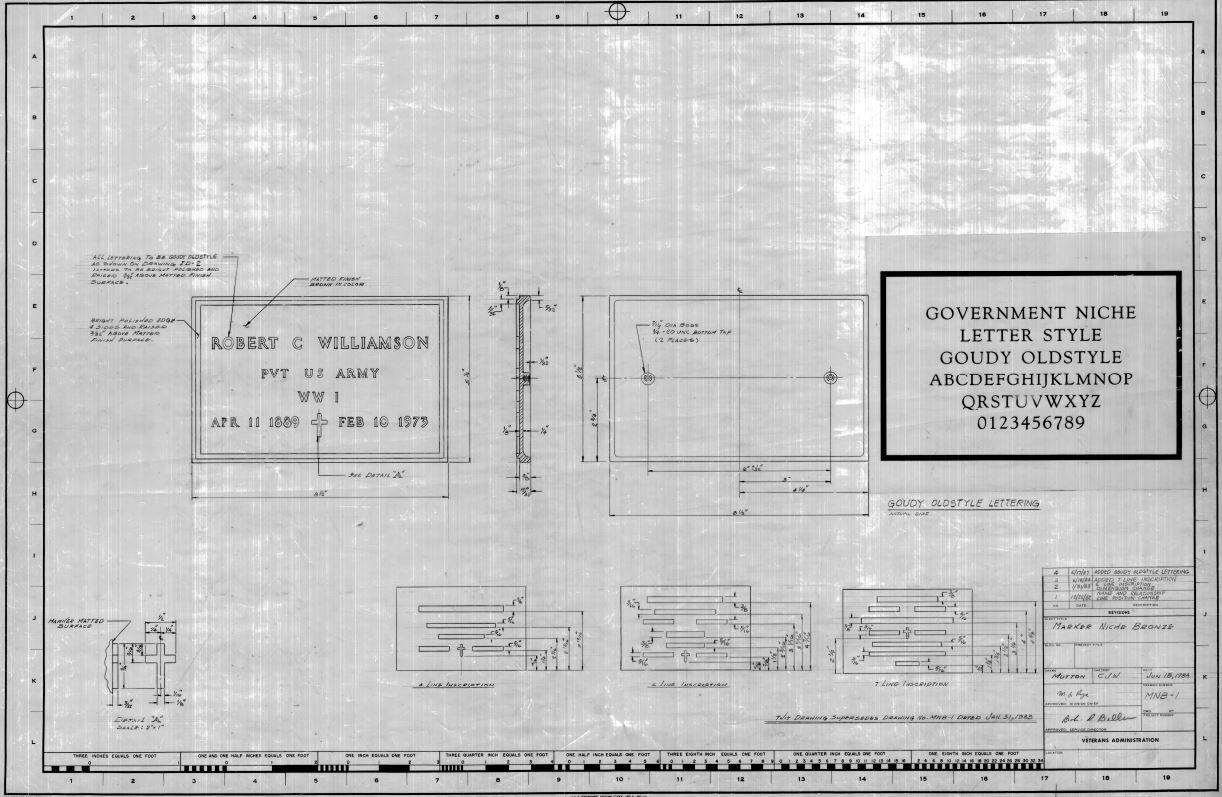 Technical drawing from 1984 showing the specifications for a government-issued bronze niche marker for use in columbaria.
Technical drawing from 1984 showing the specifications for a government-issued bronze niche marker for use in columbaria.Authorized Inscriptions
The Secretary of the Army approved the placement of the Buddhist emblem as part of the authorized inscription in February 1951. Seven months later, the Secretary of Defense directed The Secretary of the Army to include the word "Korea" as part of the authorized inscription in those instances where members of the United States Armed Forces died in Korea or whose death was attributable to service in Korea.
The above directive was superseded and reissued on December 1, 1954, to provide for inclusion of the word "Korea" on government headstones and markers for the graves of those members and former members of the United States armed forces who served within the areas of military operations in the Korean Theater between June 27, 1950 and July 27, 1954.
Then on December 11, 1964, the Special Assistant to the Secretary of the Army for Civil Functions approved the word "Vietnam" as part of the authorized inscription in those instances where members of the United States armed forces died in Vietnam, or whose death was attributable to service in Vietnam for the duration of current military activities in Vietnam or until such time as the military activities were given an official designation. The inclusion of the word "Vietnam" as part of the authorized inscription was retroactive to 1954.
The Special Assistant to the Secretary of the Army for Civil Functions approved the word "Korea" as part of the authorized inscription on the headstones of all military personnel and veterans who were on active duty during the period of June 27, 1950 through July 27, 1954 and on headstones and markers for active duty decedents who lost their lives in Korea or adjacent waters as a result of hostile action subsequent to the 1953 Armistice. The word "Vietnam" was authorized to be inscribed on the headstones and markers of all decedents who were on active duty on or after August 5, 1964 through May 7, 1975. The beginning date has been extended to February 28, 1961, for veterans who served "in country" before August 5, 1964.
On September 1, 1973, 82 of the 84 national cemeteries under the jurisdiction of the Secretary of the Army were transferred to the Administrator of Veterans Affairs. Arlington and the Soldiers' and Airmen's Home National Cemeteries remained under the Department of the Army.
On October 31, 1983, the Chief Memorial Affairs Director of the then-Veterans Administration authorized "Lebanon" or "Grenada" to be shown as the war service for those killed as a result of those military actions. Then on December 22, 1989, the Director of the National Cemetery System (now called the Under Secretary for Memorial Affairs, National Cemetery Administration), Department of Veterans Affairs, authorized "Panama" to be shown as the war service for those killed in military action in Panama, and "Persian Gulf" to be shown as the war service for all military personnel who served in that action August 2, 1990 or later.
The Director of Monument Services authorized "MIA" and "POW" to be inscribed at Government expense on December 12, 1988.
On December 4, 1992, the Director of Memorial Programs Service authorized "Somalia" to be shown as the war service for those killed as a result of military actions.
The Secretary of Veterans Affairs authorized the reintroduction of upright granite headstones on January 19, 1994.
In February 1997, the Inclusive Inscription Policy was adopted. This policy allows for additional text inscription to be provided at government expense.
Public Law 107-103, signed on December 27, 2001, allows the VA to furnish an appropriate government marker for the grave of a veteran buried in a private cemetery regardless of whether the grave is already marked with a private marker. On December 6, 2002, this law was amended to extend this benefit to veterans who died on or after September 11, 2001.

















